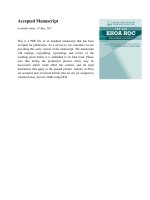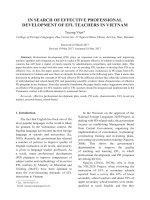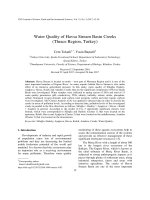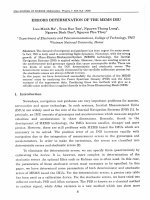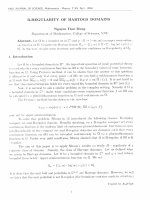DSpace at VNU: Anti-inflammatory activity of methyl ferulate isolated from Stemona tuberosa Lour
Bạn đang xem bản rút gọn của tài liệu. Xem và tải ngay bản đầy đủ của tài liệu tại đây (361.64 KB, 5 trang )
Asian Pac J Trop Med 2014; 7(Suppl 1): S327-S331
S327
Contents lists available at ScienceDirect
Asian Pacific Journal of Tropical Medicine
journal homepage:www.elsevier.com/locate/apjtm
doi: 10.1016/S1995-7645(14)60254-6
Document heading
Anti-inflammatory
tuberosa Lour
activity of methyl ferulate isolated from Stemona
1*
Nguyen Thi Mai Phuong
, Trinh Tat Cuong2, Dang Ngoc Quang3
Institute of Biotechnology, Vietnam Academy of Science and Technology, Hanoi, Vietnam
1
Key Laboratory for Enzyme and Protein Technology, Hanoi University of Science, Vietnam
2
Faculty of Chemistry, Hanoi National University of Education, Vietnam
3
ARTICLE INFO
ABSTRACT
Article history:
Received 16 May 2014
Received in revised form 23 May, 2nd revised
form 15 Jun, 3rd revised form 25 Jun 2014
Accepted 3 Aug 2014
Available online 27 Jun 2014
Objective: To evaluate the anti-inflammatory activity of methyl ferulate (MF) isolated from
the roots of Stemona tuberosa (S. tuberosa) Lour (Stemonaceae) in lipopolysaccharide activated
macrophage cells.
Methods: Methanol extracts of a root powder of S. tuberosa were prepared for isolation of
a potential anti-inflammatory agent using ultrasound extraction combined with repeated
chromatography on silica gel. After the quantitative analyses, anti-inflammatory activity of the
isolated compound was evaluated by measurement of cytokine release, NO generation, expression
of cyclooxygenase-2 and phosphorylation of mitogen activated protein kinases including p38 and
c-Jun NH2-terminal kinase using quantitative kits and Western blotting with specific antibodies.
Results: The isolation process yielded a potential anti-inflammatory compound with a purity
level of 99% determined by high performance liquid chromatography. The compound was
identified as MF by using nuclear magnetic resonance. MF strongly inhibited the release of
pro-inflammatory cytokines from macrophages, including IL-6, TNFα, IFNγ, yet it did not
affect the anti-inflammatory cytokine IL-10. Phosphorylation of p38 and c-Jun NH2-terminal
kinase were clearly reduced in MF-treated macrophages stimulated with lipopolysaccharide.
cyclooxygenase-2 expression and NO generation by macrophages were also suppressed when the
cells were treated with MF.
Conclusions: The data suggested that MF is a possible inhibitor of the mitogen activated
phosphor kinase pathway and could be a potential anti-inflammatory agent isolated for the first
time in medicinal plant S. tuberosa.
Keywords:
Stemona tuberosa
Inflammation
Toll-like 4 receptor
Macrophage
1. Introduction
Stemona tuberosa (S. tuberosa) Lour (Stemonaceae), known
as Bach Bo in Vietnam, is a hairless, perennial, herbaceous
twiner which can grow up to 4-10 m long. Its roots form a
fascicle of many thick, fleshy shoots. The root of S. tuberosa
has been used in Vietnamese traditional medicine for
its antitussive and anti-ectoparasitic activities moisten
the lungs and stop cough, as well as kill parasites[1]. The
chemical constituents of the plant are alkaloids, stilbenoides
and tocopherols[2,3]. Recently, S. tuberosa extracts have been
attracting new interest for their multi-biological functions
including anti-tuberculotic, antifungal, demulcent, and
anti-cancer activities[1,2]. However, the anti-inflammatory
*Corresponding author: Nguyen Thi Mai Phuong, Institute of Biotechnology, Vietnam
Academy of Science and Technology, Hanoi, Vietnam.
Tel: +84 917500965
Fax: +84 438360853
E-mail:
Foundation Project: Supported by Vietnam Academy of Science and Technology
(VAST) Grant No. (VAST03.02/12-13).
activity of this plant required further investigation. In this
study, we aimed to examine the anti-inflammatory activity
and potential mechanisms of action in lipopolysaccharide
(LPS)-activated macrophage cells for methyl ferulate (MF)
isolated from roots of S. tuberosa.
2. Materials and methods
2.1. Plant material
The roots of S. tuberosa and eleven other traditional
medicinal plants for screening test were collected in
Quang Binh, Thanh Hoa, Phu Tho, Hoa Binh provinces
and identified by the Institute of Ecology and Biological
Resources, Vietnam Academy of Science and Technology,
Hanoi.
2.2. Chemicals
LPS
was purchased from Sigma-Aldrich (St. Louis, MO).
S328
Nguyen Thi Mai Phuong et al./Asian Pac J Trop Med 2014; 7(Suppl 1): S327-S331
kits for IL-6, IL-10, TNFα, IFNγ were purchased from
BD Pharmingen (Franklin Lakes, NJ). Antibodies p38 and
phospho-(Thr180/Tyr182)-p38, c-Jun NH2-terminal kinase
( JNK ) and p- JNK were purchased from C ell S ignalling
T echnology ( B everly, MA ) . T he anti-cyclooxygenase- 2
(COX-2) antibody was purchased from Abfrontier (Korea). The
NO detection kit was purchased from iNtRON Biotechnology
(Korea). All chemicals used were of analytical grade.
ELISA
2.3. Extraction and isolation
The air-dried and powdered roots of S. tuberosa (2.0
kg) were extracted five times with 75% methanol (5伊10 L)
in ultrasound extracting system ( E lma, J apan ) at room
temperature and filtered. T he combined extract was
concentrated to dryness by evaporating in vacuo to give a
residue (18 g), which was used for antiflammatory screening
assays. The residue was chromatographed on silica gel
(200-300 mesh) column chromatography, eluting with an
ether:acetone gradient (9:1) to give 10 fractions E 1-10. The
further separation of fraction E4 (0.82 g) by silica gel column
chromatography eluted with a hexane:ethyl acetate gradient
(2:1), yielded ten fractions (H1-10). Compound 1 (85 mg) was
obtained from fraction H5 by preparative high performance
liquid chromatography (HPLC) (hexane-EtOAc, 2/1; flow rate
1 mL/min).
2.4. Cell culture
Primary bone marrow derived-macrophages (BMDMs) were
isolated from the bone marrow of mice, which were reviewed
and approved by the animal care unit of National Institute
of Hygiene and Epidemiology, Vietnam. The cells were
differentiated for 5-7 d in macrophage colony-stimulating
factor (M-CSF)-containing media. The medium contains
Dulbecco’s modified Eagle’s medium (DMEM, Gibco-BRL,
Gaithersburg, MD) with 10% L929 cell-conditioned medium
(as a source of M-CSF), 10% heat-inactivated fetal bovine
serum (FBS) (Gibco-BRL), 1 mmol/L sodium pyruvate, 50
5
IU/mL penicillin, 50 µg/mL streptomycin and 5伊10 mol/
L β-mercaptoethanol, sodium pyruvate, non-essential
amino acids, penicillin G (100 IU/mL), and streptomycin
( 100 µ g/m L ) . M ouse macrophage cell line, RAW 264 . 7
(American Type Culture Collection; ATCC) was maintained
in complete medium (DMEM with 10% FBS), sodium pyruvate,
non-essential amino acids, penicillin G (100 IU/mL), and
streptomycin (100 µg/mL).
2.5. Cell viability assay
Cell viability assessment was performed using a Cell
Counting Kit-8 (CCK-8, Dojindo Laboratories, Kumamoto,
Japan) as per the manufacturer’s instructions. Briefly, 10
µL of CCK-8 solution was added and incubated with treated
cells for 60 min in Corning Costar 48 well plate and then
absorbance was measured at 450 nm. Values from each
treatment were calculated as a percent relative to the
untreated control (100% survival).
2.6. ELISA
BMDMs were treated in Corning Costar 48 well plate
as indicated in the F igures 3 and 4 . T he cell-culture
supernatants were analyzed for levels of cytokines TNFα, IL6,
IL10, and IFN-γ secreted by cell culture were measured by
ELISA reagents (BD Pharmingen).
2.7. Western blotting
The treated BMDMs were processed for analysis by Western
blotting[4]. Briefly, BMDMs were treated with the test agent for
60 min in Corning Costar 48 well plate before stimulation with
LPS (1 µg/mL). The total cell lysates obtained by using lysis
buffer NP 40% (Life Technologies) were then separated by 10%
sodium dodecyl sulfate polyacrylamide gel electrophoresis
and transferred overnight to nitrocellulose membranes,
(AmershamTM HybondTM-ECL) and the nonspecific binding
of antibodies was blocked with 3% nonfat dried milk in
phosphate-buffered saline. Membranes were probed with
p38, p-p38, JNK, and p-JNK antibodies (1:1 000 dilution in
Tris-buffered saline, pH 7.4) for 2 h at room temperature.
After three washes with phosphate-buffered saline, blots
were developed by a chemiluminescence assay ( ECL ;
Amersham-Pharmacia).
2.8. Measurement of NO content
Raw 246.7 cells at density of 10 were seeded in Corning
Costar 48 well plate for 16 h before treatment. The cells were
6
treated with the test agent for 60 min and activated with 1
of LPS. The culture supernatants were obtained by
centrifuge and concentrations of NO were assessed by Griess
reaction using a NO detection kit (iNtRON Biotechnology,
Korea).
µg/mL
2.9. Determination of COX-2 expression
RAW 246.7 cells were treated with test agent in Corning
Costar 48 well plate for 60 min before stimulation with
LPS (1 µg/mL). The total cell lysates were then analyzed
with Western blot using anti–COX-2 antibody (Santa Cruz
Biotechnology Inc., Santa Cruz, CA). The antibodies were
diluted at ratio of 1:1 000. The membranes were developed by
a chemiluminescence assay (ECL; Amersham-Pharmacia).
2.10. Statistical analyses
For statistical analysis, data obtained from independent
experiments are presented as mean依SD and were analyzed
by the Student’s t-test with ANOVA for multiple comparisons.
Differences were considered significant at P<0.05.
3. Results
3.1. Isolation of potential anti-inflammatory agent(s) from
S. tuberosa extract
Macrophages and lymphocytes produce powerful proinflammatory mediators, including IL 6 , IL 1 , IL 8 , and
TNFα, one of the most important mediators that regulates
biochemical changes and symptomatic pathophysiological
responses in the human body. In later stages of sepsis,
anti-inflammatory mediators are produced ( e.g. IL 10 ) ,
leading to an abatement in the production of many of the
pro-inflammatory mediators [5]. M acrophages activated
by bacterial LPS induce antibody production and local
inflammation, which includes the release of pro-
S329
Nguyen Thi Mai Phuong et al./Asian Pac J Trop Med 2014; 7(Suppl 1): S327-S331
Table 1
The spectroscopic data of MF (CDCl3) about compound of H NMR and C NMR.
1
Position
3
d, J=16.0
7.62 d, J=16.0
5
7.03
4
6
7
1-OMe
6-OMe
7-OH
brd s
109.4
148.0
146.8
114.7
123.0
51.6
55.9
To evaluate the anti-inflammatory activity of MF, we
examined the cytotoxic effects of MF and a dexamethasone
(Dex) control on BMDMs. BMDMs were treated with MF (25 µg/
mL) or Dex (100 nmol/L) for various times, and the percentage
of surviving cells was counted using CCK-8 cell viability
assay. A s shown in F igure 2 , no significant difference
was observed for MF or Dex-induced cell viability at the
indicated times, up to 48 h (P>0.05).
120
90
60
30
0
MF
6
Time (h)
18
Dex
48
Figure 2. No effect on cell viability after treatment of BMDMs with MF or Dex.
BMDMs were seeded in Corning Costar 48 well plate at a density of 1伊10 cells/
6
well. After 3-4 d, cells were treated with MF (25 µg/mL) for the times indicated.
H
3
145.0
3.2. Effect of MF on cell viability
0
2
H
C NMR
126.9
d, J=8.5
7.07 dd, J=1.0, 8.0
3.80 s
3.93 s
5.90 s
9
13
115.2
6.92
8
13
167.7
6.28
2
COOCH3
1
Compound 1
H NMR (J, Hz)
1
1
Cell viability (%)
inflammatory cytokines, chemokines, and inflammatory
mediators[5]. Therefore, macrophage cell lines are routinely
used to evaluate the anti-inflammatory activities of crude
extracts.
In this study, assaying LPS-activated macrophages in vitro,
we screened for a potential anti-inflammatory extract from
12 traditional medicinal plants of Vietnam by measurement
of IL6 and TNFα production when LPS-induced macrophage
cells were treated with these plant extracts. We found that
a methanolic S. tuberose extract strongly inhibited proinflammatory IL6 and TNFα release while it did not affect the
release of the anti-inflammatory cytokine IL10, suggesting
that the extract possesses potential anti-inflammatory
properties (data not shown). Based on this result, S. tuberosa
was selected for isolation of the desired compound. The
isolation process was based on the bioassay-guided
chromatographic separations. Compound 1 (85 mg) in the
form of a yellow-brown oil was received by a preparative
chromatography system after two repeated silica gel column
chromatography steps showed a purity of up to 99% by
HPLC . T he obtained nuclear magnetic resonance ( NMR )
spectroscopic data indicated that compound 1 is MF with a
molecular fomular of C11H13O4 (Figure 1), which displays the
following spectral data: UV (MeOH)_max nm: 236, 322; IR
-1
(KBr) _max cm : 3424, 2903, 2649, 2549, 1744, 1670; EIMS m/z:
1
13
208 [M]+, 177, 145, 137, 131, 89, 77, 51; H and C NMR (Table 1).
F erulic acid and some derivatives, especially ethyl
ferulate, have been reported to be effective antioxidant,
anti-microbial, anti-inflammatory, hepatoprotective,
neuroprotective, anticarcinogenic, anti-diabetic, anticholesterolemic, UV -protective and radioprotective
compounds[6,7]. However, anti-inflammatory activity of MF
derivative has not been well documented.
C ell viability was assessed after incubation for indicated times in the
presence of CCK-8. Data are presented as the mean依SD of three independent
experiments.
3.3. Inhibition of MF against cytokine production by LPS
activated macrophages
Anti-inflammatory properties of MF concentrations 0, 5,
and 25 µg/mL were confirmed by examination of their
effect on pro-inflammatory cytokine production of IL-6,
IFNγ, TNFα, and post-anti-inflammatory cytokine IL-10.
The results (Figure 3) indicated that the release of IL6, INFγ,
and TNFα was strongly inhibited in BMDMs while IL10 was
4
10,
5
9
8
unaffected compared to untreated control cells (P<0.05).
6
7
OH
OCH3
Figure 1. Chemical structure of methyl ferulate isolated from S. tuberosa.
These data indicate that MF could be a good candidate for
use as an anti-inflammatory agent. At a concentration of 10
µg/mL (45 µmol/L), release of all the tested cytokines in the
treated BMDMs were suppressed by at least 50%.
3.4. MF inhibits phosphorylation by p38 and JNK in MAPK
pathway
Mitogen activated protein kinases (MAPK) are a group
S330
Nguyen Thi Mai Phuong et al./Asian Pac J Trop Med 2014; 7(Suppl 1): S327-S331
of signaling molecules that also appear to play important
roles in inflammatory processes. At least three MAP kinase
cascades are well described including, extracellular signal
and regulated kinase, JNK and p38[8,9]. These have also been
reported to differentially activate depending on the stimuli
present and cell type affected[9]. As shown in Figure 4, the
activation of p38 and JNK was significantly reduced in the
MF-treated RAW 264.7 cells at a concentration of 25 µg/mL
(compared to the control).
8 000
4 000
0
0
5.0 10.0 25.0
IFNγ (pg/mL)
MF (µg/mL)
10 000
Dex
C
5 000
0
15 000
0
5.0
10.0
MF (µg/mL)
25.0
Dex
D
10 000
5.0 10.0
MF (µg/mL)
25.0 Dex
0
0
5.0
10.0 25.0
MF (µg/mL)
Dex
Figure 3. Effect of MF on cytokines TNFα, IL6, IFNγ and IL10 produced by
macrophages.
BMDMs were treated with MF at concentrations of 0, 5, 10, and 25 µg/mL in
vehicle DMSO 0.1% in 60 min before stimulation with LPS. Supernatants were
harvested 18 h after stimulation with 1 µg/mL LPS to induce inflammation.
Concentrations of IL-10, IFNγ, IL-6, and TNFα in the culture supernatants
were determined by ELISA. Dexamethasone (Dex) was used as positive control.
Data are presented as the mean依SD of three independent experiments.
p-p38
p38
-LPS
LPS
MF+LPS
p-pJNK
8
4
0
5 000
0
16
12
4 000
15 000
0
B
IL10 (pg/mL)
TNFα (pg/mL)
8 000
16 000
12 000
NO (µg/mL)
A
IL6 (pg/mL)
16 000
12 000
to prostaglandin, resulting in pain and inflammation[10].
I nhibitors of COX - 2 have profound anti-inflammatory
effects [10]. We also examined COX-2 expression in MFtreated and LPS-stimulated BMDMs, as COX-2 is an important
inflammatory mediator that is induced by various stimuli,
including LPS and cytokines[9]. As shown in Figure 6, MF
clearly suppressed COX-2 expression at a concentration of
25 µg/mL while the inhibitory effect seems to not be very
profound at a concentration of 10 µg/mL.
-LPS
LPS
MF+LPS
pJNK
Figure 4. Inhibition of MF against p38 and JNK phosphorylation in BMDMs.
BMDM s were treated with MF at concentrations of 25 µg/m L in vehicle
DMSO 0.1% for 60 min before stimulation with LPS (1 µg/mL). The cells then
were then analyzed with Western blot using p38, p-p38, JNK, and p-JNK
antibodies.
3.5. Inhibition of MF against NO formation in BMDMs
R eactive oxygen species ( ROS ) , such as H 2 O 2 , NO ,
superoxide anions, and hydroxyl radicals (OH) are often
important intracellular signaling molecules in pathways
involved in cell proliferation, stress responses and
apoptosis[5,9]. The inhibitory effects of MF on activation of
MAPK (phosphorylation of p38 and JNK), which was mentioned
in section 3.4, suggested that p38 and JNK could be the
important signals involved in the MF-induced inhibition
of NO generation. Therefore, we investigated whether MF
inhibits LPS-induced NO generation in BMDMs. The RAW264.7
cells were treated with MF and inflammation was induced by
using LPS. The data (Figure 5) indicated that LPS-induced NO
generation was inhibited in a dose dependent manner with
about 20% and 50% inhibition at concentrations 10 and 25 µg/
mL MF, respectively.
3.6. Inhibition of MF against COX-2 expression
COX - 2 is primarily present at sites of inflammation
and plays a role in the conversion of arachidonic acid
Control
LPS
10.0 µg/mL
25.0 µg/mL
Figure 5. Inhibition of MF against NO generation in BMDMs.
6
Raw 246.7 cells at density of 10 were seeded in Corning Costar 48 well plate
for 16 h before treatment. The cells were treated with MF at concentrations of
10 and 25 ug/mL for 60 min and activated with 1 ug/mL of LPS for another 1.5
h. The culture supernatants were harvested by centrifuge and concentrations
of NO were determined using a NO detection kit. Data are presented as the
mean依SD of three independent experiments.
0
LPS
MF1
MF2
COX-2
β-Actin
Figure 6. Inhibition of MF against COX-2 expression in BMDMs.
RAW 246.7 cells were treated with MF at concentrations of 10 µg/mL (MF1)
and 25 µg/mL (MF2) in vehicle DMSO 0.1% in Corning Costar 48 well plate for
60 min before stimulation with LPS (1 µg/mL). The cells were then analyzed
with Western blot using anti COX-2 antibody.
4. Discussion
I n the treatment of inflammation, non-steroid antirheumatic drugs, such as acetylsalicylic acid, more
commonly known as aspirin or ibuprofen, have been popular
choices. However, many of these drugs cause potential
risks and side effects, such as stomach and cardiovascular
problems [11,12] . T herefore, novel anti-inflammatory,
especially natural agents are badly needed. Plants are rich
in naturally-occurring bioactive compounds. This is an ideal
bio-resource to develop new therapeutic agents[13-15]. In an
attempt to find novel anti-inflammatory agents from plants
of Vietnam, we were screened and selected S. tuberosa, a
traditional medicinal plant. We found the MF compound,
and even though it is not a new compound, this is the first
time that it has been isolated from this plant and shown to
possess anti-inflammatory activity when tested in vitro.
First, MF strongly inhibited MAPK phosphorylation induced
by LPS, which affected two important signal pathways p38
and JNK. The most well-known pathway involved in LPS-
Nguyen Thi Mai Phuong et al./Asian Pac J Trop Med 2014; 7(Suppl 1): S327-S331
induced pro-inflammatory responses in macrophages
is the MAPK pathway, which is involved intracellular
signaling cascades[8,16]. Intense efforts have been made to
develop and evaluate compounds that target components
of these pathways [9,16]. T he most extensive activity in
MAPK inhibitor development has found with pJNK and p38,
which regulate the production of TNFα and IL 1 [17]. p 38
inhibitors are expected to inhibit not only the production
of pro-inflammatory cytokines, but also their actions,
thereby interrupting the vicious cycle that often occurs in
inflammatory and immune-responsive diseases[5,9]. Our data
suggest that MF is a potential inhibitor of the MAPK pathway.
Second, several studies have demonstrated that activation
of MAPK plays a role in the regulation of inflammation by
affecting the activation of NF-κB[8,17]. Moreover, NF-κB plays
an important role in the regulation of inflammatory genes,
such as, inducible nitric oxide synthetase (iNOS), COX-2,
and TNF-α[9,10,17]. In our study, NF-κB expression was also
evaluated in BMDMs using specific antibodies to the p50/105
subunit of NF-κB. We found an only minor suppression of
NF-κB expression by MF in the Western blot image at a
concentration of 25 µg/mL (data not shown). However, the
inhibitory effect of MF on NO generation and COX-2 at the
same concentration suggests that MF could still be affecting
the NF-κB pathway. Islam et al. demonstrated that antiinflammatory activity of ethyl ferulate, another derivative of
ferulate acid comes from the inhibition of ROS production
and the significant suppression of the NF-κB activity when
the translocation of NF-κB p65 in LPS-stimulated RAW
264.7 macrophages was measured[18].This suggests that an
additional study would be warranted to further investigate
this, perhaps by employing the use of an NF-κB reporter.
Thus, it is possible that there could be cross-talk between
the MAPK and the NF-κB signals that may be important for
relaying the biological effect of MF. Moreover, Minutoli et
al. demonstrated that during the development of testicular
ischemia-reperfusion injury, the JNK and p38 signals were
abolished when NF-κB was disrupted[19]. Sethi et al. also
found that TNF-induced NF-κB activation was stopped in
cells deleted of the MKK4 gene encoding activates both JNK
and p38 MAPK[20].
In summary, the present study suggests MF is a potential
inflammatory compound isolated for the first time from
medicinal plant S. tuberosa grown in Vietnam.
Conflict of interest statement
We declare that we have no conflict of interest.
Acknowledgements
This study was accomplished with support from the Project
of the Vietnam Academy of Science and Technology (Grant
No VAST 03.02/12-13). We are grateful to Ms. Duong Thi Nu,
Ms. Tran Thi Nhung, Institute of Biotechnology, Vietnam, for
technical assistance and Dr. Megan L. Falsetta, University
of Rochester Medical Center, the US, for critical reading this
manuscript.
References
[1] Greger H. Structural relationships, distribution and biological
S331
activities of stemona alkaloids. Planta Med 2006; 72(2): 99-113.
[2] M urthy K , R ama S , R eddy MC , K ondamudi R , P ullaiah T .
Micropropagation of Stemona tuberosa Lour.—an endangered
and rare medicinal plant in Eastern Ghats of India. Indian J
Biotechnol 2013; 12: 420-424.
[3] Schinnerl J, Brem B, But PP, Vajrodaya S, Hofer O, Greger H.
Pyrrolo-and pyridoazepine alkaloids as chemical markers in
Stemona species. Phytochemistry 2007; 68(10): 1417-1427.
[4] Yang CS, Ko SR, Cho BG, Shin DM, Yuk JM, Li S, et al. The
ginsenoside metabolite compound K , a novel agonist of
glucocorticoid receptor, induces tolerance to endotoxin-induced
lethal shock. J Cell Mol Med 2008; 12: 1739-1753.
[5] A ldridge C , R azzak A , B abcock TA , H elton WS , E spat NJ .
Lipopolysaccharide-stimulated RAW 264.7 macrophage inducible
nitric oxide synthase and nitric oxide production is decreased
by an omega-3 fatty acid lipid emulsion. J Surg Res 2008; 149(2):
296-302.
[6] Paiva LBD, Goldbeck R, Santos WDD, Squina FM. Ferulic acid
and derivatives: molecules with potential application in the
pharmaceutical field. Braz J Pharm Sci 2013; 49(3): 395-411.
[7] Sultana R. Ferulic acid ethyl ester as a potential therapy in
neurodegenerative disorders. Biochim Biophys Acta 2012; 1822(5):
748-752.
[8] English JM, Cobb MH. Pharmacological inhibitors of MAPK
pathways. Trends Pharmacol Sci 2002; 23: 40-45.
[9] Park HJ, Lee HJ, Choi MS, Son DJ, Song HS, Song MJ, et al. JNK
pathway is involved in the inhibition of inflammatory target gene
expression and NF-kappaB activation by melittin. J Inflamm
(Lond) 2008; 5: 7.
[10] L ee S , S hin S , K im H , H an S , K im K , K won J , et al. A ntiinflammatory function of arctiin by inhibiting COX-2 expression
via NF-kB pathways. J Inflamm (Lond) 2011; 8: 16.
[11] Barnes PJ. Glucocorticosteroids: current and future directions. Br
J Pharmacol 2011; 163(1): 29-43.
[12] Dinarello CA. Anti-inflammatory agents: present and future. Cell
2010; 140(6): 935-950.
[13] C hao WW , L in BF. Isolation and identification of bioactive
compounds in Andrographis paniculata (Chuanxinlian). Chin Med
2010; 5: 17.
[14] Mahesh G, Ramkanth S, Mohamed Saleem TS. Anti-inflammatory
drugs from medicinal plants-a comprehensive review. Int J Rev
Life Sci 2011; 1(1): 1-10.
[15] Mayer AM, Rodríguez AD, Taglialatela-Scafati O, Fusetani N.
Marine pharmacology in 2009-2011: marine compounds with
antibacterial, antidiabetic, antifungal, anti-inflammatory,
antiprotozoal, antituberculosis, and antiviral activities; affecting
the immune and nervous systems, and other miscellaneous
mechanisms of action. Mar Drugs 2013; 11(7): 2510-2573.
[16] Janeway CA Jr, Medzhitov R. Innate immune recognition. Annu
Rev Immunol 2002; 20: 197-216.
[17] S eo MB , L ee SK , J eon YJ , I m JS . I nhibition of p 65 nuclear
translocation by Baicalein. Toxicol Res 2011; 27(2): 71-76.
[18] Islam MS, Yoshida H, Matsuki N, Ono K, Nagasaka R, Ushio H,
et al. Antioxidant, free radical-scavenging, and NF-kappaBinhibitory activities of phytosteryl ferulates: structure-activity
studies. J Pharmacol Sci 2009; 111(4): 328-337.
[19] Minutoli L, Antonuccio P, Polito F, Bitto A, Fiumara T, Squadrito
F , et al. I nvolvement of mitogen-activated protein kinases
(MAPKs) during testicular ischemia-reperfusion injury in nuclear
factor-kappaB knock-out mice. Life Sci 2007; 81(5): 413-422.
[20] Sethi G, Ahn KS, Xia D, Kurie JM, Aggarwal BB. Targeted deletion
of MKK4 gene potentiates TNF -induced apoptosis through
the down-regulation of NF-kappa B activation and NF-kappa
B-regulated antiapoptotic gene products. J Immunol 2007; 179(3):
1926-1933.


